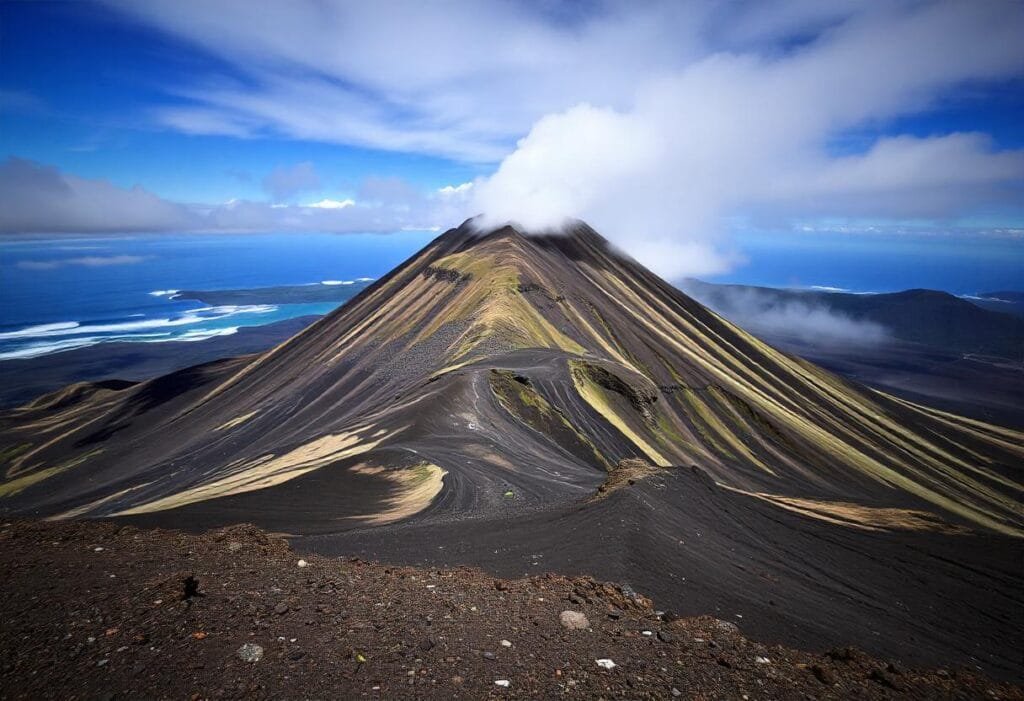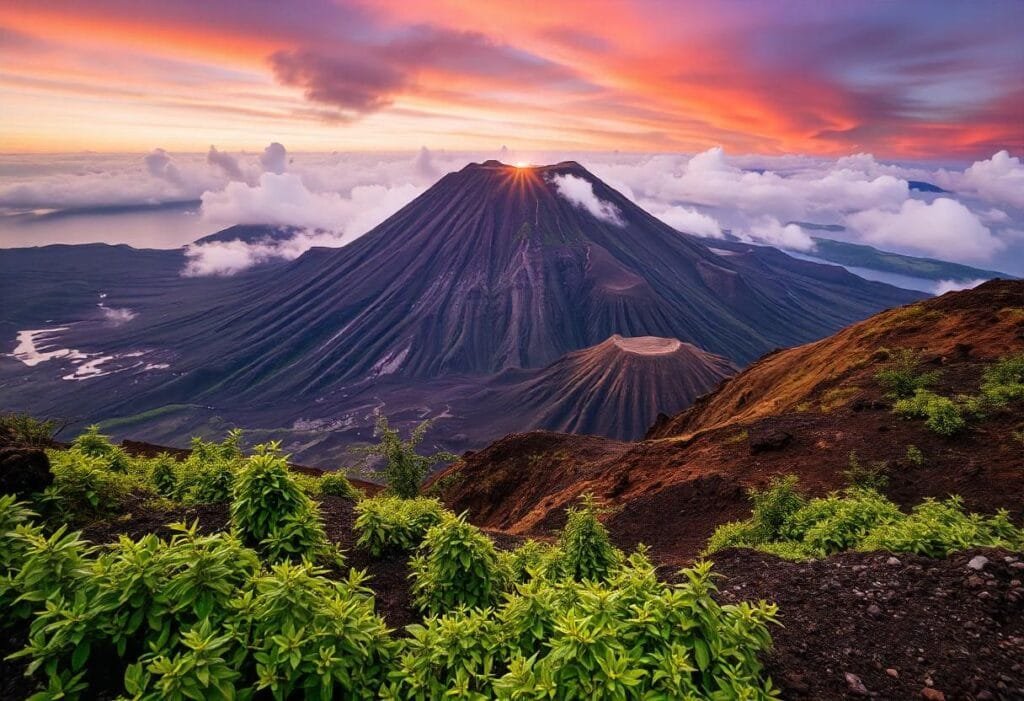Table of Contents
The unassuming volcanic, small island in the Pacific Ocean hides a treasure mostly unseen by tourists. Famous for its dramatic landscapes, full of history and with wartime military importance, Iwo Jima offers an attraction that combines adventure and reflection. Take a travel guide through every detail you should know about exploring Iwo Jima-from how to get there, must-see attractions, and cultural experiences.
Unveiling Iwo Jima: A Volcanic Jewel

Iwo Jima also known as Sulfur Island, belongs to the Ogasawara Islands chain located approximately 1,240klm south of Tokyo. This volcanic island rises steeply from the sea, and the largest and most conspicuous of all can be Mount Suribachi – a dormant volcanic cone that will rise to as high as 166 meters or 545 feet in height. The island’s landscape is quite rugged, impressive, and characterized by volcanic rock formations, lush greenery, and stunning coastal views.
Iwo Jima had a defined ecosystem by a unique history of volcanoes. Such serious environments have allowed more unique species to inhabit the island, including endemic birds and plants. The coastal and volcanic activities infuse a very lively setting for nature lovers and photography seekers.
Historically, Iwo Jima is an important landmark because it was one of the bloodiest battles of the Pacific Theatre during World War II; the photograph of Raising the Flag on Iwo Jima embodied dashing courage and sacrificing efforts by the Marines. Today, visitors view remnants of this turbulent past while appreciating the beauty of the island.
Journeying to Iwo Jima: Getting There
Travel to Iwo Jima should be planned as this is not an easily accessible island destination like most others. For tourists who intend to travel to this island, the easiest route is by air from Tokyo to Chichijima, which is the largest island in the Ogasawara Islands. From Chichijima, ferry rides to Iwo Jima are available.
Transportation Options
Transportation Methods
There are actually flights from Haneda but there are more flights from Narita which take about an hour and a half to two hours depending on the departure and arrival points. The negative aspect is that sometimes flights might be limited, so booking well in advance is a must.
After landing on Chichijima, you can take a ferry from this island to Iwo Jima, but with a pretty irregular schedule of sometimes just two times a week. The ride takes around two hours and the views of the surrounding ocean and islands are beautiful. A tip is to pay attention to changes in weather conditions because bad weather can change the ferry schedule.
The other option is private charters and even guided tours; transportation to Iwo Jima can be included with these. These would be pricier options, but they would guarantee a very personalized and adventurous approach.
Recommended Scenic Routes for the Journey
For those coming from Tokyo to Chichijima, you may take some time here or visit places in and around the Ogasawara Islands before going into the islands themselves. The islands are a perfect destination for scenery, wildlife, and cultural experiences.
The ferry ride was great, viewing dolphins and other marine life; the scenic ride would be as exciting as the destination: breathtaking ocean views with islands to set the adventure on Iwo Jima.
Top Attractions on Iwo Jima
Mount Suribachi
The primary symbol of the island is the Iwo Jima Mount Suribachi. There is a popular option for a visitor to climb to the top, offering stunning views over the island and the surrounding ocean. Pathways to the summit are well-signed and accessible to nearly all fitness levels.
Climbing, you will view strange rock formations of volcanic origin and abundant foliage. The summit itself is marked by a huge crater, further reminding one of the volcanic origins of the island. The panoramic views from the top are terrific, taking in the seas as well as a few other islands on the horizon.
Iwo Jima Memorial
The Iwo Jima Memorial, for instance, can be said to be an image of the historical importance this island represented. It is a standing monument, erected as a tribute to the sacrifice those Marines made that fought during the Battle of Iwo Jima. It showcases an image of the famous flag-raising photograph.
Visiting the memorial will be such an emotional experience because it will remind you to think deeply and reflect on the sacrifices due to fighting for your country. The surrounding area also holds lots of historical artifacts and markers that would tell a story of the battle and its significance in American history.
Japanese War Memorials
These memorials stand all over Iwo Jima to honor Japanese soldiers who had fought on the island then. While both locales give a historical perspective on the confusing parts of the island and on those parts of the American and Japanese servicemen, visiting these memorials deepens cultural insight into the understanding of the island and its people affected by the invasion of the war.
Beaches and Natural Landscapes
Iwo Jima also has beautiful beaches with breathtaking natural landscapes. People come to the airfield beach for rest and reflection. The waters call out for you to take a plunge into them while the soft sands provide the perfect setting for sunbathing or an ideal picnic.
For the nature lover, Iwo Jima presents the refreshing experience of hiking on the coastlines. Volcanic rock formations as well as impressive views along the coastlines define this landscape and is quite perfect for photographers as well as explorers. Do carry your camera along to capture, in a frame, the wondrous sunsets painted across the sky in vibrant hues.
Cultural Experiences and Local Cuisine
Nothing less than a visit to Iwo Jima can be experienced without encountering the locals through indulgence in their culture as well as cuisine.
Local Dishes to Try
One can hardly enjoy a meal out while staying on Iwo Jima, as the list of available food and beverage options is very limited. However, some mouth-watering local food can be tried. Seafood is a feature that shines through Iwo Jima because of its rich marine life. Look for fresh fish dishes; you will often have grilled fish and sashimi accompanied by local vegetables and rice.
Another one is soba noodles which you can find at local restaurants. Buckwheat noodles, being part of basic Japanese cuisine, could give a more comfortable feeling at the end of a day full of exploration.
Cultural Events and Festivals
Iwo Jima is a small island, but it sometimes stages cultural activities and festivals that pay homage to history and heritage. If a visit falls within an event, I would join in and get closer to the locals and experience performances, music, and cuisine.
One such event is the Iwo Jima Memorial Ceremony, which is conducted every year to pay respects to the enormous courage of those who battled for this particular battle. Such events have enabled you to be connected to the history of this island and the respect that has been paid to it in the past.
Outdoor Adventures on Iwo Jima
For any outdoor activity lover, Iwo Jima is a great place to explore some of the most startling natural experiences on the island.
Hiking Trails
Other trails aside from Mount Suribachi can be found at Iwo Jima, as well as variations in levels of difficulty. The pathways take you through foliage, volcanic rock, and the coastline.
A very popular trail is the West Coast Hiking Trail, which is best for seeing wildlife and gives you a better hiking experience. Clothing – Also, don footwear according to the terrain; do not forget to bring some water and food for the trip.
Scuba Diving and Snorkeling
The water surrounding Iwo Jima is teeming with marine life; hence, it is an excellent destination for diving and snorkeling. The coral reefs and marine environments enable one to explore a planet of colorful animation, gorgeous colored fish, and sculptures of particular rock formations.
Several local tour operators offer guided scuba diving and snorkel tours. Local operators will ensure that you have all the necessary equipment and expertise to fully take advantage of your underwater adventure.
Wildlife Viewing
Iwo Jima is home to many bird species, as well as quite a few rare wildlife species, so it’s a perfect site for birdwatching and wildlife photography. There are several types of ecosystems on the island that account for most of the endemic species offered, and on the island alone, offer the opportunity to see animals in their original habitats.
The best time to watch wildlife is rising soon and setting late in the morning or in the evening. Consequently, take binoculars and a camera to the island to check and photograph diverse plants and animals.
Check Out: Hakone: Your Ultimate Volcano Mountain Travel Guide.
Accommodation Options on Iwo Jima

Accommodation on Iwo Jima can be challenging to seek because it lacks a lot of accommodations, but there are some options available for travelers.
Lodging Choices
Guesthouses and small inns can be found on the island as well where you can make an overnight stop. These generally have the least amount of amenities and provide a warm and friendly place where you will be dealt with more local hospitality.
One of the most visited places is Iwo Jima Lodge which will provide you with nice accommodations and means for circumnavigating the attractions on the island. A night in one of the inns belonging to the locals will let you feel the experience of the culture and community more deeply.
Camping Facilities
Camping is an excellent alternative for outdoor enthusiasts. There are campsites where one can go and pitch a tent and feel the strong presence of nature. Campsites usually offer amenities such as bathrooms and cooking facilities that give convenient access while staying.
Specially, one has to check the weather and be prepared accordingly as the conditions tend to change rapidly in volcanic areas. Camping on Iwo Jima can be really experienced when it comes to discovering the beauty of the island, mainly under the stars.
Conclusion
A destination so captivating, bringing with it natural beauty, historical significance, and adventures outside. Iwo Jima is a place that stands from hiking through volcanic trails to acquaintances with its rich history, which brings back memories for a lifetime. If you are a history lover, if you like to travel outdoors, if you are seeking some places with historical importance outside of the typical touristy lists, Iwo Jima would not be a place to be missed.
For more in-dept info: Click Here.
FAQs
What is the best time to visit Iwo Jima?
The authors recommended that visitors should consider the spring season which includes, March, April, and May, and the autumn season which ranges from September to November since the climate will be appropriate for touring. Summer is quite hot and humid and the winters may bring rough seas that may not be advisable for visitors.
Are there any safety concerns for travelers?
While Iwo Jima is considered generally safe for tourists, it would be wise to check on weather conditions and tidal conditions. Before getting outside to hike and before engaging in any water activities of any kind, get updates from local officials on current conditions, as well as maintain any type of safety precautions.
Can I find guided tours available on Iwo Jima?
Indeed, there are very few guided tours on Iwo Jima and those that are available are more or less historical sites and outdoor excursions. It is best made as early as possible because the availability of the tour is limited by the size and accessibility of the island.


